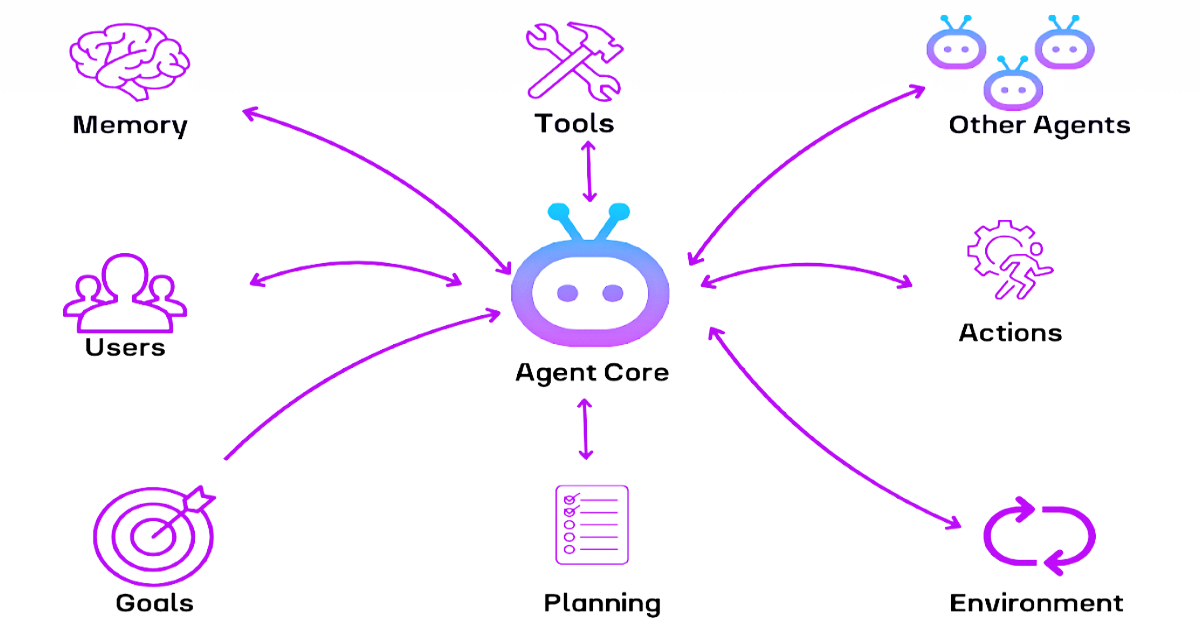Core Agent Team Design

Discover the Key to Unlocking Scalable AI and Automation Potential.
Core Agent Team Design is key for scalable AI and automation success. It helps organisations create and use effective AI and automation solutions. This design focuses on a structured way to handle AI, automation, and full-stack development.
By grasping the core principles, organisations can fully use AI and automation for success.

Core Agent Team Design is vital for making AI and automation solutions that grow with your business. It makes development smoother, ensuring solutions are efficient and scalable. With this design, companies can grow by using AI and automation wisely.
Introduction to Core Agent Team Design
As more businesses use AI and automation, a clear development plan is crucial. Core Agent Team Design offers a framework for effective AI and automation solutions. It helps organisations reach scalable AI and automation success.
Understanding Core Agent Team Design is the first step to unlocking AI and automation's full potential.
Key Takeaways
- Core Agent Team Design is essential for achieving scalable AI and automation success
- The definition and purpose of Core Agent Team Design are centred around creating a structured approach to AI, automation, and full-stack development
- Core Agent Team Design enables organisations to streamline their development processes and achieve automation success
- Organisations can drive business growth through the strategic implementation of AI and automation technologies using Core Agent Team Design
- Understanding the core principles of Core Agent Team Design is crucial for unlocking the full potential of scalable AI and automation success
- Core Agent Team Design provides a framework for organisations to develop and implement effective AI and automation solutions
Understanding Core Agent Team Design
The Role of Core Agents in Modern Development
- They make things more efficient and productive.
- They help in making better decisions and solving problems.
- They make systems more adaptable and flexible. With Core Agents, developers can build smarter, more independent systems. These systems can drive innovation and growth in many areas.
Essential Components of an Effective Agent Team Structure
An effective agent team structure has several key parts. At its core are AI Engineering experts. They create and use artificial intelligence to guide the team's choices. They work with Automation Specialists to add automation. This makes the team's work flow better and faster. Full-Stack Development experts are also vital. They build the software that helps the team work. Data Science specialists are key too. They look at and understand complex data. This helps the team make smart, informed decisions.
- Developing and implementing AI and automation solutions
- Designing and developing software applications
- Analyzing and interpreting complex data sets
- Integrating automation technologies to enhance efficiency When these parts come together, a team can work very well. They can grow and succeed. The mix of AI Engineering, Automation Specialists, Full-Stack Development, and Data Science helps the team make smart choices. They can innovate and stay ahead.
Revolutionising Traditional Development Approaches Traditional development methods are changing thanks to Core Agent Teams. They bring Innovation to the forefront. This new approach makes projects more efficient, scalable, and successful. It helps teams work better, leading to happier customers. Core Agent Teams differ from old methods in how they work. They are more flexible and can adapt quickly. This flexibility leads to new ideas and technologies in the industry. Some benefits of Core Agent Teams include:
- Improved collaboration and communication among team members
- Increased efficiency and productivity
- Enhanced adaptability and responsiveness to changing project requirements

Organisations that adopt Core Agent Teams and Innovation will succeed more. As the industry grows, we'll see more changes in Traditional Development. These changes will be driven by Core Agent Teams.
The Key to Scalable AI and Automation Success
Organisations aiming for Automation Success need a solid base. Scalable AI helps them grow and adapt. It makes sure systems and processes work well, even when demands rise. Scalable AI focuses on using resources wisely. This means planning and adjusting to meet the organisation's needs. It helps businesses get the most from their investments and succeed in automation. Building Blocks of Scalable AI
- Flexible Frameworks that can adapt to changing requirements
- Efficient Resource Allocation to maximise returns on investment
- Continuous monitoring and evaluation to ensure Automation Success By focusing on these areas, organisations can reach the best of Scalable AI. The right Frameworks and Resource Allocation lead to growth, better efficiency, and staying competitive.
Essential Tools and Technologies for Agent Teams
Agent teams need various tools and technologies to work well. AI-Driven Task Management tools like Jira, Trello, and Asana help a lot. They make it easier for teams to work together and get projects done.
These tools help teams manage tasks, keep track of progress, and meet deadlines. This ensures projects are delivered smoothly. Automation Frameworks such as Selenium and Robotic Process Automation (RPA) are also key. They automate simple tasks, letting team members focus on harder tasks. This makes processes faster, reduces mistakes, and boosts efficiency. DevOps Tools like Docker and Kubernetes are vital too. They help teams quickly deploy and manage apps. This means faster delivery and better quality. Using these tools, teams can work better together, automate more, and deploy faster, leading to better project results.
Using these tools brings many benefits, including:
- Improved collaboration and communication
- Increased automation and efficiency
- Enhanced project delivery and quality
- Faster time-to-market and reduced costs

By using AI-Driven Task Management, Automation Frameworks, and DevOps Tools, agent teams can reach their best. They can innovate and deliver top-quality projects that meet business needs.
Implementing Core Agent Teams in Enterprise Environments
When adding core agent teams to Enterprise Environments, we must think about the current setup. A good Adoption Strategies plan is key for a smooth transition. We need to check the organization's current state, find where core agent teams can help, and plan how to introduce them. Effective Change Management is crucial. It means knowing the company's culture and talking well to everyone. Training and support help employees get used to new ways of working. This ensures the benefits of core agent teams are seen. Here are some top tips for adding core agent teams to Enterprise Environments:
- Know the organization's goals and what it wants to achieve
- Find out where core agent teams can make a difference
- Make a detailed Adoption Strategies and Change Management plan
- Keep training and supporting employees By using these tips and thinking about the specific needs of their company, businesses can successfully add core agent teams. This leads to better efficiency, productivity, and innovation in Enterprise Environments.
Overcoming Common Implementation Challenges
Organisations face many Implementation Challenges when setting up core agent teams. These can include Technical Integration and Team Coordination issues. A solid plan is key to overcoming these hurdles. Ensuring Technical Integration is crucial. This means linking the core agent team with current systems and tech. Breaking down this task into smaller steps helps avoid mistakes. Good Team Coordination is also vital. It means all team members work well together. This is done through regular talks and teamwork. A supportive team environment helps overcome Team Coordination problems.
- Conducting thorough risk assessments to identify potential challenges
- Developing a comprehensive project plan to ensure effective Technical Integration and Team Coordination
- Providing ongoing training and support to team members to ensure they have the necessary skills and knowledge
Real-World Applications and Success Stories
Core Agent Teams have played a big role in many industries. They have brought about Real-World Applications and Success Stories. Thanks to them, companies can now use AI and automation on a large scale. This has changed how they work, making things more efficient. They have helped businesses in many ways. For example, they've made processes smoother, helped with making better decisions, and encouraged new ideas. This shows how Core Agent Teams can make a big difference. Core Agent Teams are great because they can fit into many different situations. They've been used in things like improving supply chains and making customer service better. Their success stories prove how powerful they can be. There are many Success Stories of Core Agent Teams. They've been used in healthcare, finance, and transport. In these areas, they've helped improve patient care, find financial problems, and plan better routes. These examples show how Core Agent Teams can lead to innovation and growth. Looking at the Success Stories of Core Agent Teams gives us important lessons. We can use this knowledge to make future Core Agent Teams even better. This will help them achieve more in the real world.
Future Trends and Innovations in Agent Team Design
Looking ahead, Future Trends in agent team design will shape the future of core teams. AI and automation are becoming more common. This means Innovations in team design are key to success. The next decade will bring big changes in Agent Team Design. Teams will become more efficient and effective. Some important areas for Future Trends include:
- Improved collaboration and communication between agents
- Increased use of AI and machine learning to enhance decision-making
- Greater emphasis on flexibility and adaptability in team design
As businesses change and adapt, the role of Innovations in agent team design grows. By embracing Future Trends and Agent Team Design, companies can stay competitive and reach their goals.
Conclusion: Embracing the Future of AI-Driven Development
The design of core agent teams is key to unlocking AI's full potential. It leads to scalable success. Businesses can change their development for the better, work more efficiently, and keep up with tech trends. The core agent team model is the future of software development. It focuses on teamwork, AI, and smart workflows. This way, teams can use automation and AI to work better, innovate faster, and meet customer needs. As the world changes, we need smarter, faster development solutions. Using core agent teams in their plans, businesses can thrive in the future of AI.
FAQ
What is core agent team design?
Core agent team design is a way to develop software. It focuses on working together to make AI and automation better. It brings together AI engineers, automation experts, full-stack developers, and data scientists into one team.
How does core agent team design apply to AI and automation development?
This design is great for AI and automation because it makes different roles work well together. It helps create applications that use AI to solve big problems. The team works together smoothly, making AI and automation solutions better.
What are the key principles behind an efficient agent-based team structure?
An efficient team structure is based on a few key things. It needs autonomy, where everyone works on their own. It also needs teamwork and communication. The team should be able to adapt and grow. And, it should always be looking for ways to get better.
What is the role of core agents in AI and automation development?
Core agents are very important in AI and automation. They help different parts of the team work together. This makes solving problems more efficient. They also help make sure everything works well together.
What are the key components of a core agent team?
A core agent team has a few key roles. There are AI engineers, who make AI models work. There are automation specialists, who make things run smoothly. Full-stack developers build digital platforms. Data scientists use data to improve things. And, DevOps engineers make sure everything runs smoothly.
How does a core agent team differ from a traditional development team?
Core agent teams are different from traditional teams. They work together more and make decisions on their own. This makes them more efficient and able to grow AI and automation faster.
How can businesses structure an effective core agent team?
To make a good core agent team, businesses should define roles clearly. They should encourage teamwork and open communication. They should use tools to manage tasks well. Training is important for everyone to keep getting better. And, they should use AI to help manage projects.
What tools and technologies are essential for core agent teams?
Core agent teams use many tools to work better. They use AI for task management, like Jira and Trello. They use automation tools like Selenium. They also use DevOps tools like Docker. And, they use data tools to make decisions.
How can businesses scale a core agent team for growth?
To grow a core agent team, businesses should have a flexible structure. They should train people to work well together. They should use AI to manage resources. They should have clear ways for teams to work together. And, they should always look for ways to improve.
What are the common challenges in implementing core agent teams?
There are a few challenges when starting a core agent team. It can be hard to get everyone on the same page. Managing complex projects can be tough. Keeping innovation going without getting stuck is a challenge. Changing how things work can be hard. And, finding the right balance between working alone and together is tricky.